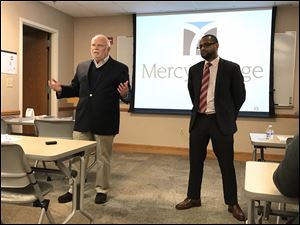
Pro and con leave audience still unclear on Issue 2
10/31/2017
Jim Ruvolo and Derek Barnett give pro-and-con sides of Issue 2 to students and staff at Mercy College of Ohio
Speakers both for and against Issue 2, the prescription question on the statewide ballot, argued their cases in front of students and staff of Mercy College of Ohio in Toledo Tuesday, but some listeners were still confused.
After pro-Issue 2 speaker Derek Barnett and anti-Issue 2 speaker Jim Ruvolo finished giving their prepared remarks explaining the ballot question, the first question was: “What does Issue 2 do?”
And the second question was, “can you dumb it down a little bit more?”
And the third question began, “I’m actually confused.”
“This issue isn’t confusing. The problem with this issue is it’s too simplistic,” said Mr. Ruvolo. The former Lucas County and Ohio Democratic chairman is a consultant for the No on Issue 2 side.
His opponent said the opponents of Issue 2 are making it more complicated than it is.
“The voters are confused and it’s understandable with all the ads on the air, on both sides,” said Mr. Barnett, who is a consultant i Cleveland for the AIDS Healthcare Foundation, a California nonprofit that put the question on the Ohio ballot. “It’s a very uncomplicated proposal but we have a very powerful opponent in the pharmaceutical industry that’s fully funding the no side.”
The issue is a petition initiative that, if approved by Ohio voters on Nov. 7, would create a new state law. The law would require the state to pay no more for prescription drugs than does the U.S. Department of Veterans Affairs, which, by federal law gets a 24-percent discount on its drugs.
The law directly applies only to people who get their drugs through the state - those on Medicaid, which is federally funded health care for the poor, or state employees, state prisoners, and state retirees, about 4 million people in total. Proponents of Issue 2 say that it will save the state $400 million that can be spent in better ways.
Mr. Barnett said Issue 2 is a way of forcing out into the open the pricing policies of drug manufacturers so the public has more leverage in negotiating prices.
“People will know what the benchmark price is. There will be transparency. I don’t see a reasonable solution coming out of Washington,” Mr. Barnett said.
Mr. Ruvolo cited a series of problems with the proposal. He said the law only applies to drugs purchased by the VA, and the VA, because it primarily serves older men, may not have the drugs needed by women and children.
He said the state already gets a discount of 23 percent on drugs purchased by Medicaid, and Medicaid accounts for 75 percent of the drugs purchased by the state, meaning there would be “negligible” savings.
Mr. Ruvolo also said the threat to people who get their drugs through private insurance or Medicare - which are not directly affected by the proposed law - would likely see higher prescription drugs as the drug companies seek to recoup their savings from the Issue 2 mandate.
He also said that the VA distributes drugs by mail and through its own pharmacies, whereas Ohio pays pharmacies for the drugs its clients use. Mr. Ruvolo said the law doesn’t have a mechanism for paying the pharmacies for their costs beyond the price of the drugs themselves, which might discourage pharmacies from doing business with the state.
“The main group to be helped is going to be hurt by this proposal,” he said.
“It’s bad public policy,” Mr. Ruvolo said of the proposed law, acknowledging that the impulse to strike a blow against the pharmaceutical industry can be powerful. “Do you support bad public policy because you want to stick it to someone?”
Contact Tom Troy at tomtroy@theblade.com, 419-724-6058, or on Twitter @TomFTroy.